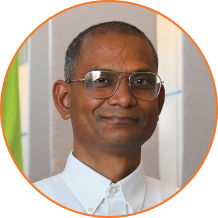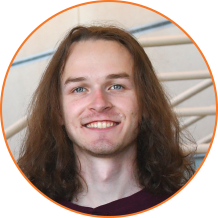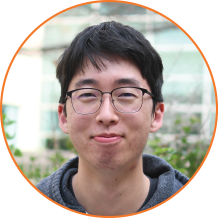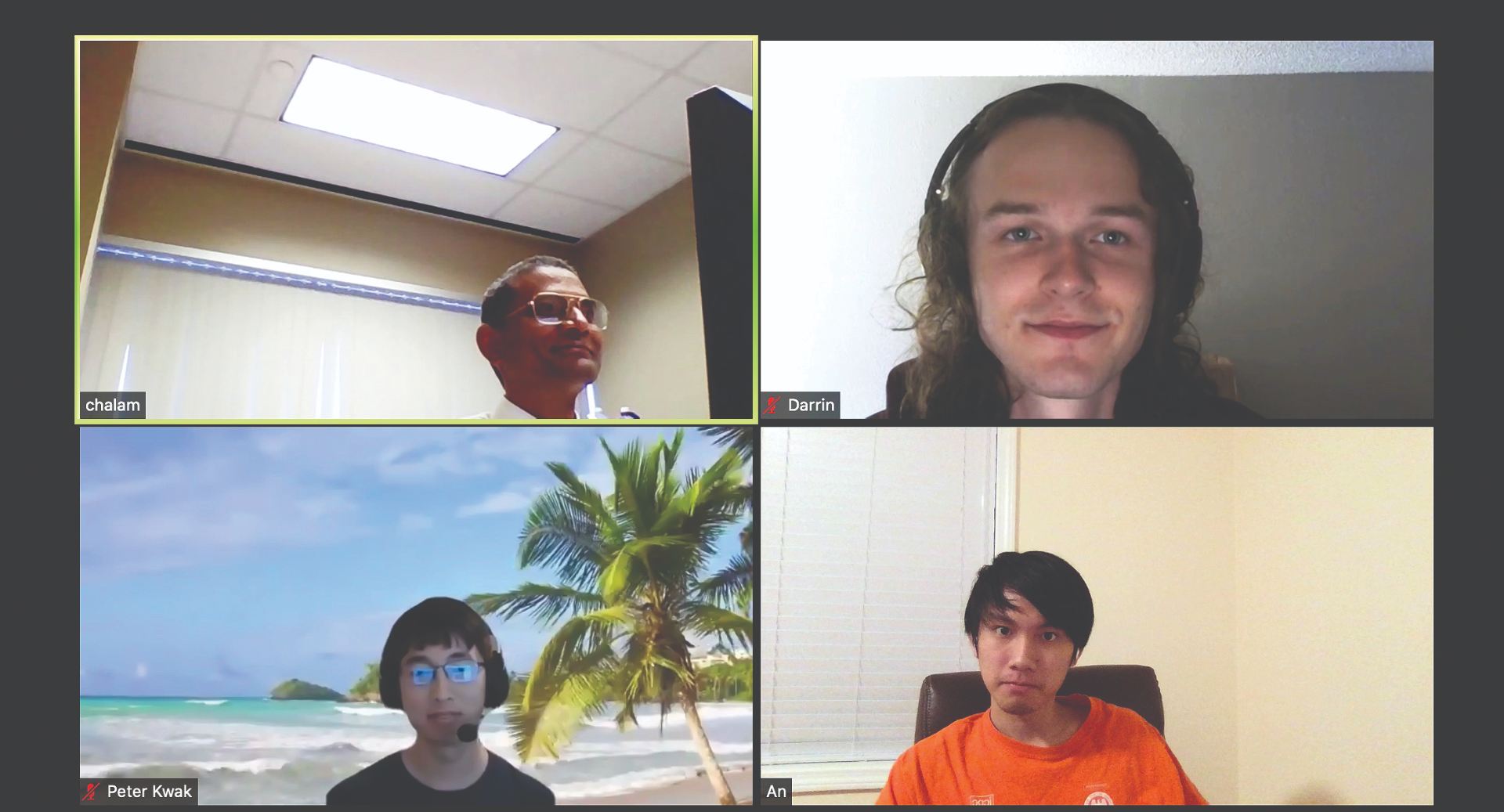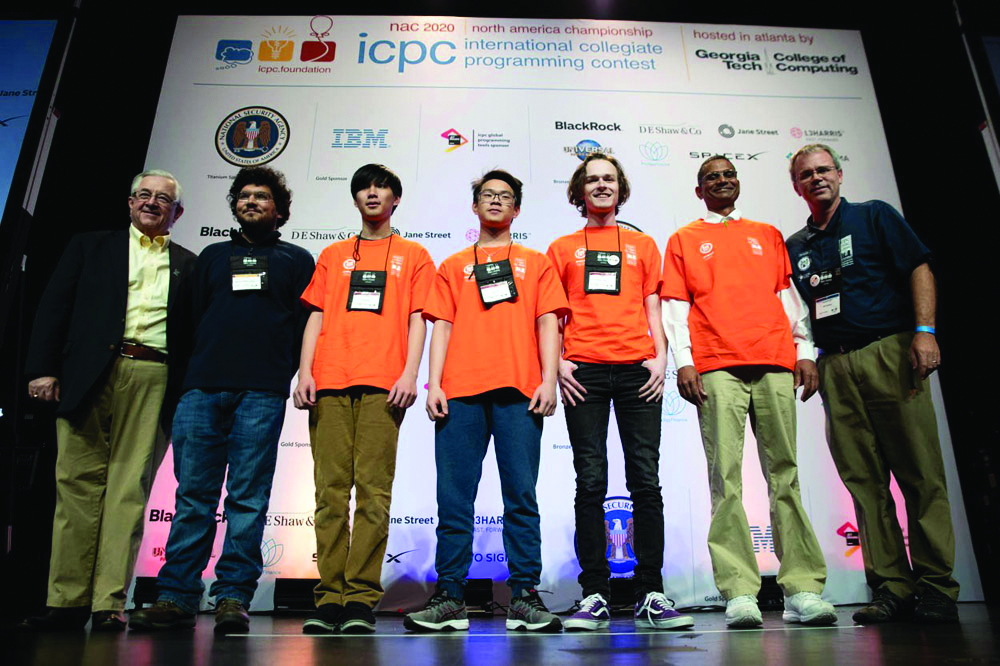
Above: The 2020 team qualified for the world finals after finishing 15th out of 65 teams in the ICPC North America Championship in February 2021. (Left to right): Dr. Bill Poucher, ICPC executive director; Mohammadreza (Reza) Haghpanah, the team’s assistant coach; An Q. Nguyen; Duy Vu; Darrin Wiley BS’19; Bhadrachalam Chitturi PhD’07, the team’s coach and associate professor of instruction in computer science; and Dr. Jeff Donahoo, ICPC deputy executive director
During the next season, Vu (left) returned as a teammate for a second year of competition, Chitturi (center) returned as the team coach and Wiley (right) served as assistant coach.
A team from the Erik Jonsson School of Engineering and Computer Science returned to the International Collegiate Programming Contest (ICPC) North America Championship where they qualified for a second straight year for the ICPC World Finals, the world championship event held fall 2022. The powerhouse team was recruited through Codeburners, a student coding club at The University of Texas at Dallas.
“I think I was lucky,” said Duy Vu, computer science senior. “We knew about each other, but we didn’t know for sure how our team would work together until the regional competition.”
The competition that began in the 1970s is considered the world’s premiere programming competition. More than 60,000 students participate from more than 3,000 universities representing as many as 115 countries.
“If you think about the hundreds of thousands of students studying computer science, then take high-performing teams, you can see why it’s a challenge even to make it past regionals,” Daescu said. “UT Dallas teams qualified not only for nationals but also for the world competition two years in a row, which shows that this is not a fluke.”
Peter Kwak joined the team in 2021.
FORMING A COMPETITIVE TEAM
In the competition, teams of three students have up to five hours to solve a set of new problems that require skills in advanced algorithms, data structure and mathematics, as well as programming languages. One problem at nationals in 2021 included planning the largest possible robot that could strategically clean a rectangular room and not be hindered by obstructions. Another required students to compute the longest subarray that is both mountainous or strictly increasing then strictly decreasing and a palindrome, or the same sequence forward and backward from a series of integers.
“You can enter five competitions, maximum,” Wiley said. “Fortunately, my last possible competition, we qualified for the world competition. But I still wanted to stay involved with the team.”
The UT Dallas team participated in a virtual-only competition, including recruiting new team member Kwak and practicing remotely. Wiley also stayed on as a coach.
Vu said that the remote competition provided a very different experience.
“We could not meet in person, so we had to meet online once a week,” he said. “We were in three different time zones.
“Also, Peter’s strengths were different from Darrin’s, so we needed to adapt.”
Wiley observed that coaching as a former team member helped to build continuity, which led to the team’s success.
“Coaching has been a great experience,” Wiley said. “My coaching style was as a fourth participant, which has allowed me to stay sharp. I also had to consider the strengths that a new team member contributed. Peter had not participated in competitive programming previously, but he’s easily one of the best at UT Dallas now.”
Both Wiley and Vu had been competitive programmers in high school. They formed a team through Codeburners, the UT Dallas competitive programming club. They discovered their next team member through a chance encounter at their academic advisor’s office.
During the COVID-19 pandemic, both practices and competitions were hosted remotely, providing unique communication and collaboration challenges.
HIGHLY COMPETITIVE QUALIFIERS
In 2021, students faced an additional competition in order to qualify for the national championship. The North American Division Championship (NADC) was added following the regional competition, so students had to be well placed at regionals, then NADC, then North American Championship (NAC) in order to qualify for the world finals.
“The structure at nationals has changed,” Chitturi said. “Previously, they hosted a regional competition as a qualifier for the national competition. Now, students also need to compete in the North American Division Championship in order to qualify for the nationals.”
While the team competed in a virtual format at regionals, they were able to improve their standing by placing first, outranking regional teams from major private and public institutions.
Finally, the ICPC North America Championship was held in early August 2021. UT Dallas placed 8th out of 48 teams. Teams within the top 10 included the Massachusetts Institute of Technology, the Georgia Institute of Technology and the University of California, San Diego.
The UT Dallas team first qualified for the world competition in Moscow in October 2021, then returned for a second national championship where they qualified for world again. The 2022 world competition was held in November in Dhaka, Bangladesh, where the UT Dallas team received an honorable mention.
“This is the most prestigious team competition in computer science,” Chitturi said. “Getting there is not a small accomplishment.”
After gaining world recognition, competitors often go on to high-profile careers in the tech industry.
“I really encourage students to go for higher education,” Chitturi said. “An is now a master’s student at Brown University, and Darrin is a PhD student at UT Dallas. I am encouraging Peter and Duy to earn their advanced degrees as well.”
Competitors say they most value the lessons in teamwork.
“This was the first time I competed on a team,” Vu said. “We had to communicate, correct each other’s code, focus on the strengths of our team, work remotely and become more efficient. I definitely think this experience will help my future work in industry.”
Discover More
Ahead In The Count
Devyn Yanello, Conference Softball Player to WatchA lot can happen in the 43 feet between the pitcher’s mound and home plate. Standing on the rise, Devyn Yanello reads the sign from the catcher. Her unspoken intention — send the batter back to the dugout. Earlier this year, Yanello, a mechanical...
Partner Profile
ENTREPRENEUR STEPS UP BUSINESS THROUGH UTDESIGN PROGRAMSRick Tett MS’21, center, tests the rotating virtual reality controller chair created by one of his many capstone teams. Braydon Schramm BS’21, second from right, was Tett’s first hire at HoboLoco.Students in the UTDesign® Makerspace spend...
DISTINGUISHED LECTURER CONNECTS ENGINEERING, EQUITY AND INCLUSION
Dr. Yvette Pearson, vice president for diversity, equity and inclusion at UT Dallas, tells audience members that user-centered design integrates the entire user experience throughout the iterative process.I n the wake of George Floyd’s murder in...
Leaving The Nest
IDEAS TAKING FLIGHT All innovation begins with a question, an idea. Researchers make big theoretical inquiries, examine microscopic problems or simply look out the window at practical issues ready to be tackled. The laboratory acts as a home — a...
A Circle of Mentorship
SOCIETY OF WOMEN ENGINEERS HONORED FOR EXCELLENCE Medha Aiyah BS’21, graduate student in computer science, met engineer Lisa Depew when she worked on her Girl Scout Gold Award project to create a solar cars curriculum as a high school student in El...
Scientist in the A.M., ‘Snack’ in the P.M.
Bioengineering PhD student Leroy Arthur was at a Dallas restaurant with friends when he received what seemed like a random message through his Instagram account, which shows a video of him skydiving and photos of him fashion modeling and spending time with friends and...


